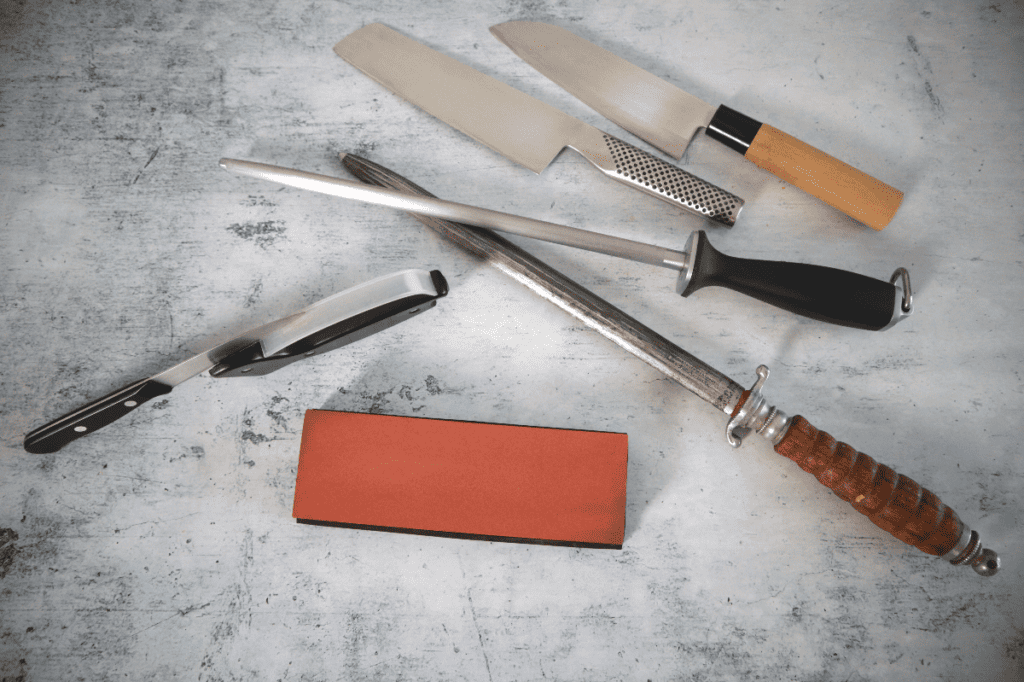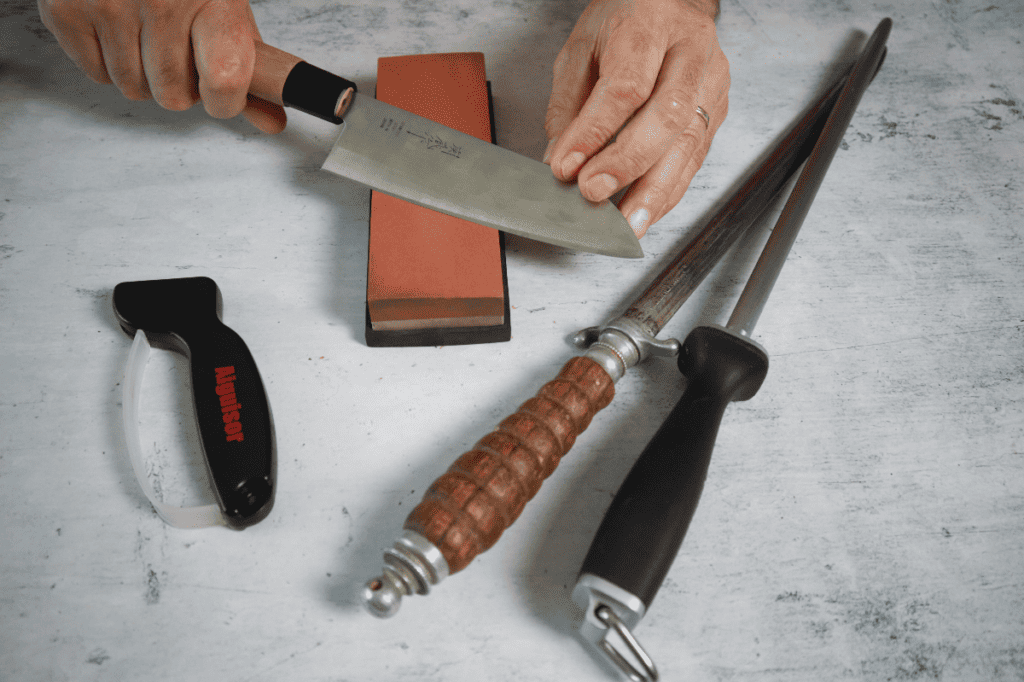How to Sharpen Kitchen Knives
| Mini guides to kitchen knives: Kinds of kitchen knives | Materials and construction | Storing | Sharpening | Maintaining sharpness | Rust removal | Disposal | Knife skills | Western or Japanese knives | Main kitchen knife guide |

Dull knives make cutting, dicing, and slicing a difficult task while sharp knives are a pleasure to work with.
It is really important to keep your kitchen knives in good condition, maintain them properly, and sharpen them when necessary.Many people think that because they are only cooking at home, they don’t need to sharpen their knives. They often believe that only professional chefs in restaurants take the time to do this.
The truth is most knives will need sharpening at one time or another. Basically, this process involves refining the edge of the blade to restore its original sharpness, which does decrease over time due to regular wear and tear.
Of course, sharpening kitchen knives requires a careful balance of precision and pressure, ensuring that the blade is honed evenly without causing damage. Sharpening will give you better efficiency with your knives and more importantly, more safety. To be honest, when done correctly, it adds to the joy of food preparation and decreases the frustrations!
Therefore, to help you, this guide will answer many questions you have about how to sharpen kitchen knives.
What angle to sharpen kitchen knives
The angle to sharpen your kitchen knives depends on the type of knife, and the exact angle can also vary depending on the brand. Always be careful when sharpening knives and use appropriate sharpening tools.
What degree to sharpen kitchen knives
Most western knives need sharpening at an angle between 15 to 20 degrees but if you are sharpening for the first time, you may want to check the manufacturer’s recommendations for your particular knife. Japanese style knives are usually sharpened at a lower angle of 10 to 15 degrees.
How to sharpen kitchen knives with rods?
A rod or honing steel can be referred to as a sharpening steel, whet steel, sharpening stick, sharpening rod, or butcher’s steel. Keep in mind that sharpening with a whetstone will be needed at certain times, but using a rod will help you to maintain the edge and sharpness for longer.

- Hold the steel and knife with the knife’s sharp edge facing away from you. Keep a firm grip on both the steel and the knife. Tilt the blade at the correct angle, depending on the type of knife you are honing.
- We recommend beginners to sharpen on one side of the blade first and do the other side after. Start at the base of the blade near the handle, and gently slide the blade along the length of the steel, moving from the base to the tip. The entire length of the blade should stay in contact with the steel at all times.
- Repeat these movements about 10 to 15 times or until you achieve the desired sharpness.
How to sharpen kitchen knives with a whetstone?
You need to make the whetstone wet and soak it in water or if you do it our way, you can keep it under running water.
- Make sure the stone is secured and can’t move. It is usually delivered with a rubber protection but if not, use a towel to keep it in place.
- Hold the knife in one hand and use your other hand on the blade to apply gentle pressure.
- Hold the knife at the correct angle and slide it from the heel to the tip of the knife over the whetstone. Repeat this a few times, and when one side is finished you can do exactly the same on the other side.

What grit whetstone for kitchen knives?
Being a chef we often get the request to sharpen knives for friends or family. There are various types of grit whetstones, but having the 3 basic ones of 1000, 3000, and 8000 grit stones is sufficient.
We recommend starting sharpening with a 1000 grit, then moving to 3000 grit and finishing with 8000 grit. The 1000 grit stone will sharpen your knife but leave the edge a bit rough while the 3000 will smooth the edge and the 8000 is for a finer finish.
How often should you sharpen kitchen knives?
How often knives need sharpening depends on the quality, the type of knives, the materials they’re made of, the cutting technique and surface and how often they are used.
As professional chefs we sharpen our chef’s knives more regularly than home cooks. Simply because we use them every day, and can assess more quickly when a knife is getting dull. We have knives that are sharpened about every two weeks.
Full sharpening however is needed less frequently when regular honing is done on the knives – every 2-4 uses maintains the edge for longer.
Serrated knives don’t need frequent sharpening because they are used less frequently and therefore every 6-12 months is usually sufficient.
For other knives it is difficult to say. We realise that many prefer to use paring knives for many cutting tasks and these should be sharpened regularly, but the reality is that this task is neglected and we often need to sharpen them when helping out in friends’ kitchens.
Proper cutting surfaces such as wood or plastic cutting boards prolong the time between sharpening and a good cutting technique with a gentle slicing or chopping motion as well as avoiding twisting the knife will protect the blade.
How to sharpen serrated kitchen knives
- Determine the bevel side. The other side should be flat and it is the beveled side that needs sharpening.
- Choose the correct honing steel. A ceramic rod is the best choice for sharpening serrated knives. Choose a round shape that fits in between the serrations. For heavily damaged serrated knives that need repair, you might want to use a diamond rod to remove material and restore the teeth.
- Hold the rod and the knife correctly and run the rod through each of the serrations at a slight angle. Gently move the knife back and forth on the rod with little pressure. A slight burr should be formed on the flat side of the knife which means the sharpening is done correctly. Then move on to the next gullet until you have done them all.
- Once all gullets are finished it is necessary to remove the burr which is easily done by running the flat side of the knife a few times along the rod or a whetstone.
Recap on how to sharpen kitchen knives at home
We’ve put together a little graphic to show you the different types of kitchen knives and the method how to sharpen them.

Legend for how to sharpen your kitchen knives
Each color X corresponds to a different sharpening method. Here’s what each color means:
Blue: whetstone method/honing rod
This method is used for chef’s knife, utility knife, paring knife, santoku knife, and carving knife. the technique involves using a whetstone at a 15-20 degree angle in an arc motion.
Green: serrated knife technique
This is specifically for bread knife and other serrated knives. the technique requires a serrated knife sharpener or a honing rod that fits into the serrations.
Coral: flexible blade technique
This is used for boning knife and fillet knife, which have flexible blades. the method involves using a whetstone or a fine honing steel with shallow angles and gentle strokes.
Yellow: thick blade technique
This method is for the cleaver, which has a thicker blade. it involves using a whetstone or a diamond sharpening stone with a steeper angle than that used for a chef’s knife.
Final note on how to sharpen kitchen knives
Mastering the art of sharpening kitchen knives is an essential skill for any home cook or professional chef. By following the steps outlined in this guide, you can ensure that your knives remain sharp, safe, and efficient.
Regular maintenance, including cleaning rust from your knives, and the use of the right tools will not only improve your cooking endeavours, but also prolong the life of your knives. Remember, a sharp knife is a valuable kitchen tool and also a safer one.
So, we recommend investing the time and effort into the proper and regular sharpening of your kitchen knives.